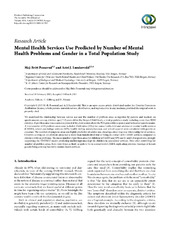| dc.contributor.author | Posserud, Maj-Britt Rocio | |
| dc.contributor.author | Lundervold, Astri | |
| dc.date.accessioned | 2016-08-03T07:31:32Z | |
| dc.date.available | 2016-08-03T07:31:32Z | |
| dc.date.issued | 2013 | |
| dc.Published | Scientific World Journal 2013, 247283 | eng |
| dc.identifier.issn | 1537-744X | |
| dc.identifier.uri | https://hdl.handle.net/1956/12405 | |
| dc.description.abstract | We examined the relationship between service use and the number of problem areas as reported by parents and teachers on questionnaires among children aged 7–9 years old in the Bergen Child Study, a total population study including more than 9000 children. A problem area was counted as present if the child scored above the 95th percentile on parent and/or teacher questionnaire. A total number of 13 problem areas were included. Odd ratios (ORs) for contact with child and adolescent mental health services (CAMH), school psychology services (SPS), health visiting nurse/physician, and school support were calculated with gender as covariate. The number of symptom areas was highly predictive of service use, showing a dose-response relationship for all services. Children scoring on ≥4 problem areas had a more than hundredfold risk of being in contact with CAMH services compared to children without problems. The mean number of problem areas for children in CAMH and SPS was 6.1 and 4.4 respectively, strongly supporting the ESSENCE model predicting multisymptomatology in children in specialized services. Even after controlling for number of problem areas, boys were twice as likely as girls to be in contact with CAMH, replicating previous findings of female gender being a strong barrier to mental health services. | en_US |
| dc.language.iso | eng | eng |
| dc.publisher | Hindawi | eng |
| dc.rights | Attribution CC BY | eng |
| dc.rights.uri | http://creativecommons.org/licenses/by/3.0/ | eng |
| dc.title | Mental health services use predicted by number of mental health problems and gender in a total population study | eng |
| dc.type | Peer reviewed | |
| dc.type | Journal article | |
| dc.date.updated | 2016-04-08T07:47:17Z | |
| dc.description.version | publishedVersion | |
| dc.rights.holder | Copyright 2013 Maj-Britt Posserud and Astri J. Lundervold | eng |
| dc.identifier.doi | https://doi.org/10.1155/2013/247283 | |
| dc.identifier.cristin | 1030810 | |
| dc.subject.nsi | VDP::Samfunnsvitenskap: 200::Psykologi: 260::Biologisk psykologi: 261 | |
| dc.subject.nsi | VDP::Social sciences: 200::Psychology: 260::Biological psychology: 261 | |
| dc.subject.nsi | VDP::Medisinske fag: 700::Klinisk medisinske fag: 750::Psykiatri, barnepsykiatri: 757 | |
| dc.subject.nsi | VDP::Midical sciences: 700::Clinical medical sciences: 750::Psychiatry, child psychiatry: 757 | |

